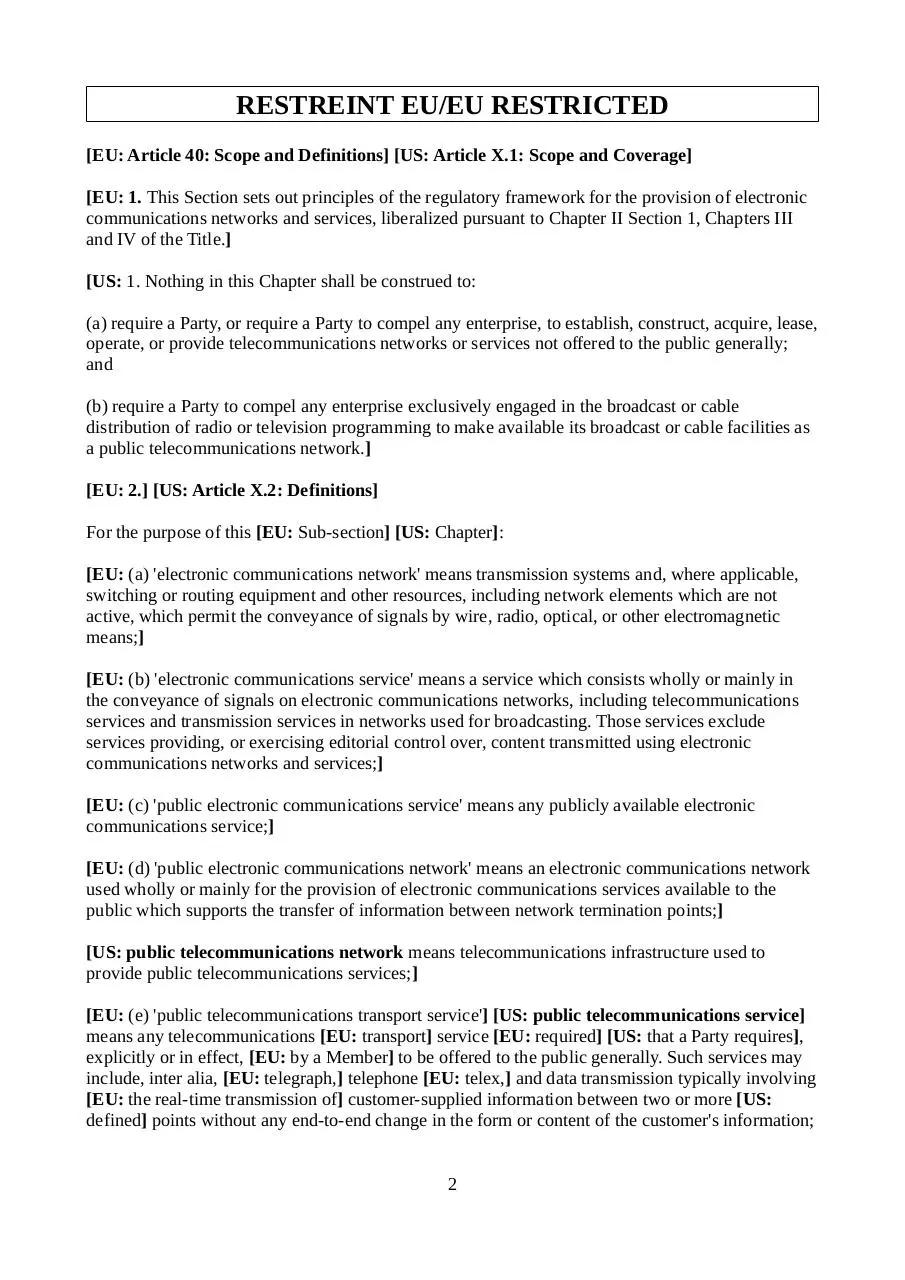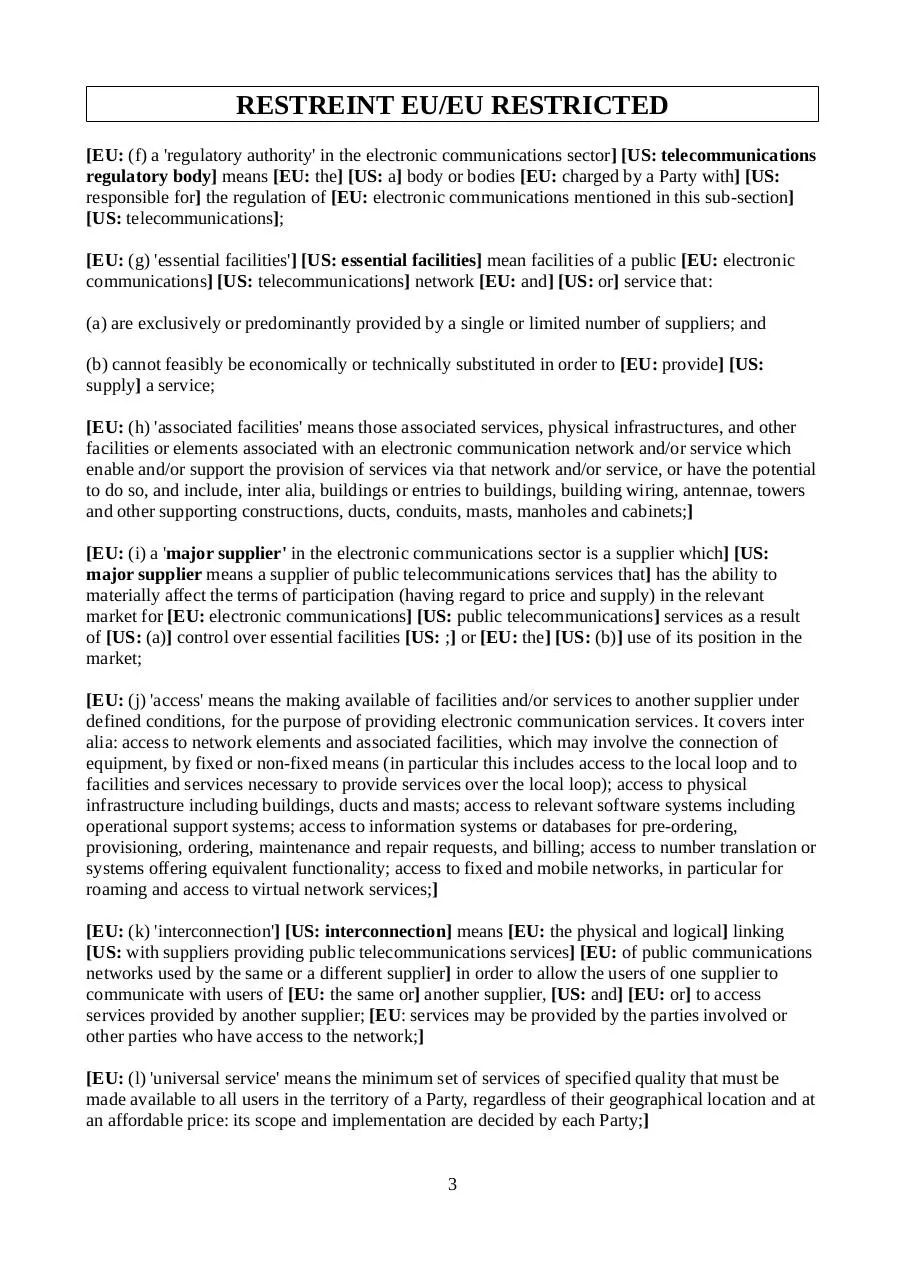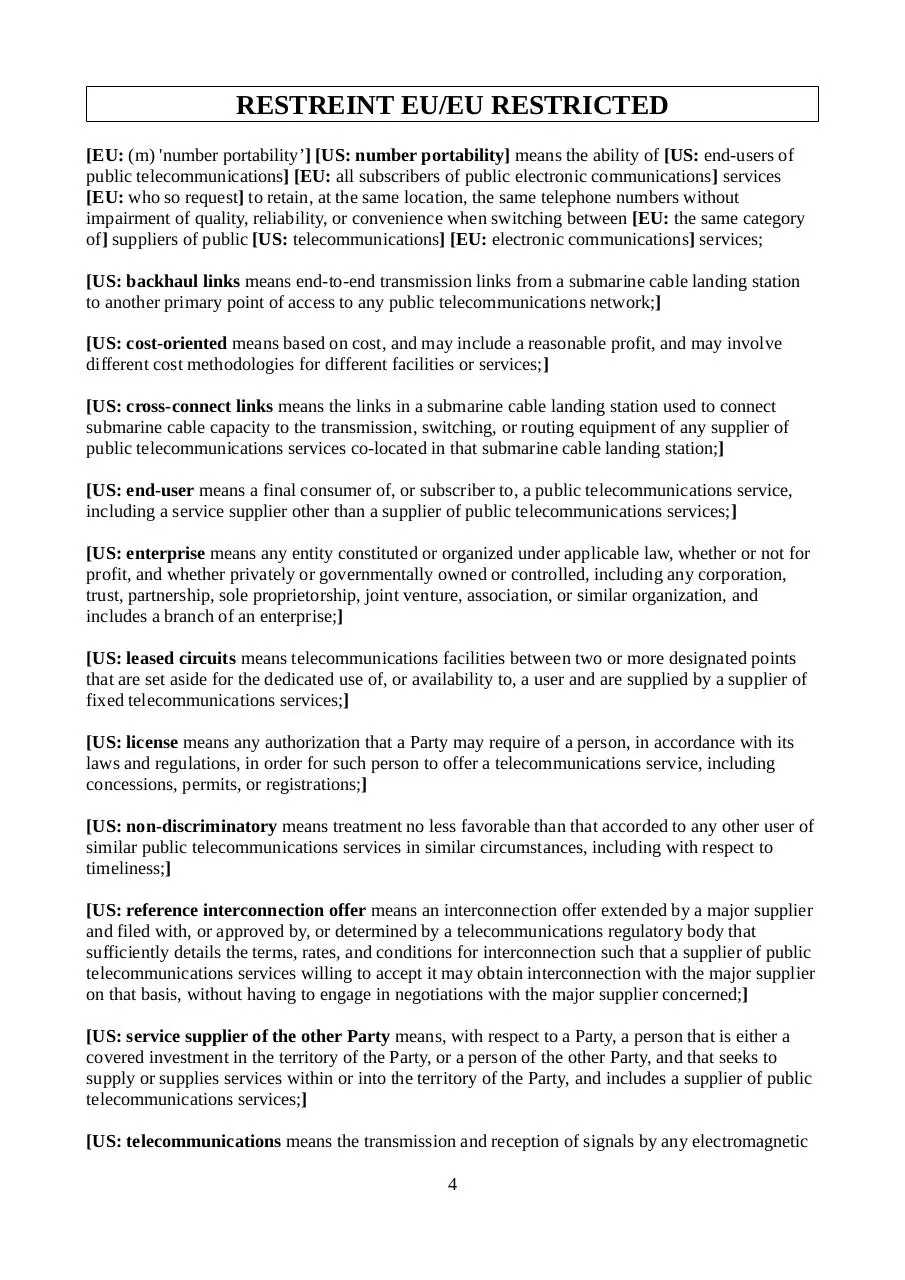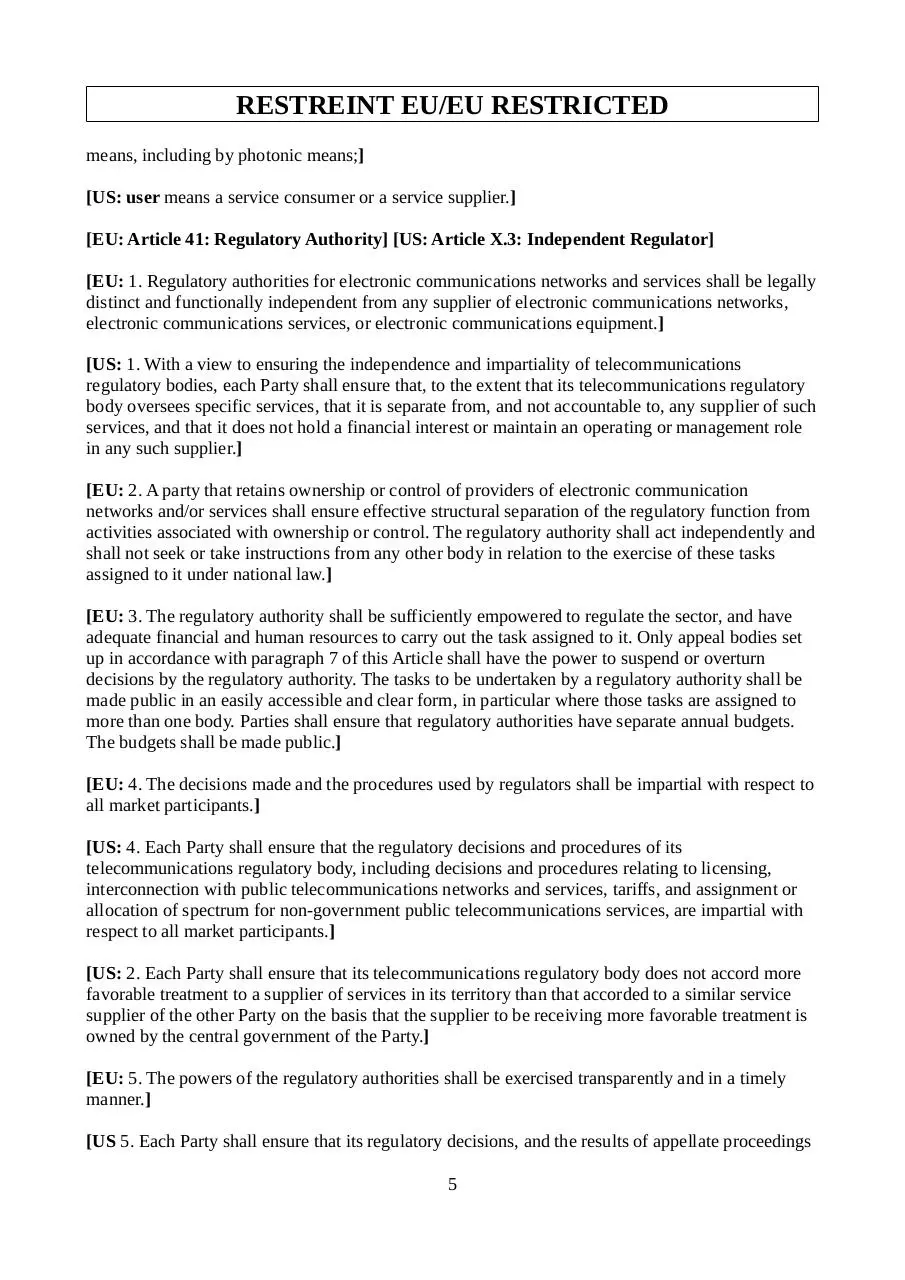doc4 (PDF)
File information
This PDF 1.3 document has been generated by , and has been sent on pdf-archive.com on 03/05/2016 at 16:18, from IP address 178.10.x.x.
The current document download page has been viewed 592 times.
File size: 85.82 KB (17 pages).
Privacy: public file





File preview
RESTREINT EU/EU RESTRICTED
Transatlantic Trade and Investment Partnership (TTIP)
Chapter [ ]
Consolidated Proposed
Electronic Communications / Telecommunications Text
1
RESTREINT EU/EU RESTRICTED
[EU: Article 40: Scope and Definitions] [US: Article X.1: Scope and Coverage]
[EU: 1. This Section sets out principles of the regulatory framework for the provision of electronic
communications networks and services, liberalized pursuant to Chapter II Section 1, Chapters III
and IV of the Title.]
[US: 1. Nothing in this Chapter shall be construed to:
(a) require a Party, or require a Party to compel any enterprise, to establish, construct, acquire, lease,
operate, or provide telecommunications networks or services not offered to the public generally;
and
(b) require a Party to compel any enterprise exclusively engaged in the broadcast or cable
distribution of radio or television programming to make available its broadcast or cable facilities as
a public telecommunications network.]
[EU: 2.] [US: Article X.2: Definitions]
For the purpose of this [EU: Sub-section] [US: Chapter]:
[EU: (a) 'electronic communications network' means transmission systems and, where applicable,
switching or routing equipment and other resources, including network elements which are not
active, which permit the conveyance of signals by wire, radio, optical, or other electromagnetic
means;]
[EU: (b) 'electronic communications service' means a service which consists wholly or mainly in
the conveyance of signals on electronic communications networks, including telecommunications
services and transmission services in networks used for broadcasting. Those services exclude
services providing, or exercising editorial control over, content transmitted using electronic
communications networks and services;]
[EU: (c) 'public electronic communications service' means any publicly available electronic
communications service;]
[EU: (d) 'public electronic communications network' means an electronic communications network
used wholly or mainly for the provision of electronic communications services available to the
public which supports the transfer of information between network termination points;]
[US: public telecommunications network means telecommunications infrastructure used to
provide public telecommunications services;]
[EU: (e) 'public telecommunications transport service'] [US: public telecommunications service]
means any telecommunications [EU: transport] service [EU: required] [US: that a Party requires],
explicitly or in effect, [EU: by a Member] to be offered to the public generally. Such services may
include, inter alia, [EU: telegraph,] telephone [EU: telex,] and data transmission typically involving
[EU: the real-time transmission of] customer-supplied information between two or more [US:
defined] points without any end-to-end change in the form or content of the customer's information;
2
RESTREINT EU/EU RESTRICTED
[EU: (f) a 'regulatory authority' in the electronic communications sector] [US: telecommunications
regulatory body] means [EU: the] [US: a] body or bodies [EU: charged by a Party with] [US:
responsible for] the regulation of [EU: electronic communications mentioned in this sub-section]
[US: telecommunications];
[EU: (g) 'essential facilities'] [US: essential facilities] mean facilities of a public [EU: electronic
communications] [US: telecommunications] network [EU: and] [US: or] service that:
(a) are exclusively or predominantly provided by a single or limited number of suppliers; and
(b) cannot feasibly be economically or technically substituted in order to [EU: provide] [US:
supply] a service;
[EU: (h) 'associated facilities' means those associated services, physical infrastructures, and other
facilities or elements associated with an electronic communication network and/or service which
enable and/or support the provision of services via that network and/or service, or have the potential
to do so, and include, inter alia, buildings or entries to buildings, building wiring, antennae, towers
and other supporting constructions, ducts, conduits, masts, manholes and cabinets;]
[EU: (i) a 'major supplier' in the electronic communications sector is a supplier which] [US:
major supplier means a supplier of public telecommunications services that] has the ability to
materially affect the terms of participation (having regard to price and supply) in the relevant
market for [EU: electronic communications] [US: public telecommunications] services as a result
of [US: (a)] control over essential facilities [US: ;] or [EU: the] [US: (b)] use of its position in the
market;
[EU: (j) 'access' means the making available of facilities and/or services to another supplier under
defined conditions, for the purpose of providing electronic communication services. It covers inter
alia: access to network elements and associated facilities, which may involve the connection of
equipment, by fixed or non-fixed means (in particular this includes access to the local loop and to
facilities and services necessary to provide services over the local loop); access to physical
infrastructure including buildings, ducts and masts; access to relevant software systems including
operational support systems; access to information systems or databases for pre-ordering,
provisioning, ordering, maintenance and repair requests, and billing; access to number translation or
systems offering equivalent functionality; access to fixed and mobile networks, in particular for
roaming and access to virtual network services;]
[EU: (k) 'interconnection'] [US: interconnection] means [EU: the physical and logical] linking
[US: with suppliers providing public telecommunications services] [EU: of public communications
networks used by the same or a different supplier] in order to allow the users of one supplier to
communicate with users of [EU: the same or] another supplier, [US: and] [EU: or] to access
services provided by another supplier; [EU: services may be provided by the parties involved or
other parties who have access to the network;]
[EU: (l) 'universal service' means the minimum set of services of specified quality that must be
made available to all users in the territory of a Party, regardless of their geographical location and at
an affordable price: its scope and implementation are decided by each Party;]
3
RESTREINT EU/EU RESTRICTED
[EU: (m) 'number portability’] [US: number portability] means the ability of [US: end-users of
public telecommunications] [EU: all subscribers of public electronic communications] services
[EU: who so request] to retain, at the same location, the same telephone numbers without
impairment of quality, reliability, or convenience when switching between [EU: the same category
of] suppliers of public [US: telecommunications] [EU: electronic communications] services;
[US: backhaul links means end-to-end transmission links from a submarine cable landing station
to another primary point of access to any public telecommunications network;]
[US: cost-oriented means based on cost, and may include a reasonable profit, and may involve
different cost methodologies for different facilities or services;]
[US: cross-connect links means the links in a submarine cable landing station used to connect
submarine cable capacity to the transmission, switching, or routing equipment of any supplier of
public telecommunications services co-located in that submarine cable landing station;]
[US: end-user means a final consumer of, or subscriber to, a public telecommunications service,
including a service supplier other than a supplier of public telecommunications services;]
[US: enterprise means any entity constituted or organized under applicable law, whether or not for
profit, and whether privately or governmentally owned or controlled, including any corporation,
trust, partnership, sole proprietorship, joint venture, association, or similar organization, and
includes a branch of an enterprise;]
[US: leased circuits means telecommunications facilities between two or more designated points
that are set aside for the dedicated use of, or availability to, a user and are supplied by a supplier of
fixed telecommunications services;]
[US: license means any authorization that a Party may require of a person, in accordance with its
laws and regulations, in order for such person to offer a telecommunications service, including
concessions, permits, or registrations;]
[US: non-discriminatory means treatment no less favorable than that accorded to any other user of
similar public telecommunications services in similar circumstances, including with respect to
timeliness;]
[US: reference interconnection offer means an interconnection offer extended by a major supplier
and filed with, or approved by, or determined by a telecommunications regulatory body that
sufficiently details the terms, rates, and conditions for interconnection such that a supplier of public
telecommunications services willing to accept it may obtain interconnection with the major supplier
on that basis, without having to engage in negotiations with the major supplier concerned;]
[US: service supplier of the other Party means, with respect to a Party, a person that is either a
covered investment in the territory of the Party, or a person of the other Party, and that seeks to
supply or supplies services within or into the territory of the Party, and includes a supplier of public
telecommunications services;]
[US: telecommunications means the transmission and reception of signals by any electromagnetic
4
RESTREINT EU/EU RESTRICTED
means, including by photonic means;]
[US: user means a service consumer or a service supplier.]
[EU: Article 41: Regulatory Authority] [US: Article X.3: Independent Regulator]
[EU: 1. Regulatory authorities for electronic communications networks and services shall be legally
distinct and functionally independent from any supplier of electronic communications networks,
electronic communications services, or electronic communications equipment.]
[US: 1. With a view to ensuring the independence and impartiality of telecommunications
regulatory bodies, each Party shall ensure that, to the extent that its telecommunications regulatory
body oversees specific services, that it is separate from, and not accountable to, any supplier of such
services, and that it does not hold a financial interest or maintain an operating or management role
in any such supplier.]
[EU: 2. A party that retains ownership or control of providers of electronic communication
networks and/or services shall ensure effective structural separation of the regulatory function from
activities associated with ownership or control. The regulatory authority shall act independently and
shall not seek or take instructions from any other body in relation to the exercise of these tasks
assigned to it under national law.]
[EU: 3. The regulatory authority shall be sufficiently empowered to regulate the sector, and have
adequate financial and human resources to carry out the task assigned to it. Only appeal bodies set
up in accordance with paragraph 7 of this Article shall have the power to suspend or overturn
decisions by the regulatory authority. The tasks to be undertaken by a regulatory authority shall be
made public in an easily accessible and clear form, in particular where those tasks are assigned to
more than one body. Parties shall ensure that regulatory authorities have separate annual budgets.
The budgets shall be made public.]
[EU: 4. The decisions made and the procedures used by regulators shall be impartial with respect to
all market participants.]
[US: 4. Each Party shall ensure that the regulatory decisions and procedures of its
telecommunications regulatory body, including decisions and procedures relating to licensing,
interconnection with public telecommunications networks and services, tariffs, and assignment or
allocation of spectrum for non-government public telecommunications services, are impartial with
respect to all market participants.]
[US: 2. Each Party shall ensure that its telecommunications regulatory body does not accord more
favorable treatment to a supplier of services in its territory than that accorded to a similar service
supplier of the other Party on the basis that the supplier to be receiving more favorable treatment is
owned by the central government of the Party.]
[EU: 5. The powers of the regulatory authorities shall be exercised transparently and in a timely
manner.]
[US 5. Each Party shall ensure that its regulatory decisions, and the results of appellate proceedings
5
RESTREINT EU/EU RESTRICTED
regarding such decisions, are made publicly available.]
[EU: 6. Regulatory authorities shall have the power to ensure that suppliers of electronic
communications networks and services provide them, promptly upon request, with all the
information, including financial information, which is necessary to enable the regulatory authorities
to carry out their tasks in accordance with this sub-section. Information requested shall be
proportionate to the performance of the regulatory authorities' tasks and treated in accordance with
the requirements of confidentiality.
7. Any user or supplier affected by the decision of a regulatory authority shall have a right to appeal
against that decision to an appeal body that is independent of the parties involved. This body, which
may be a court, shall have the appropriate expertise to enable it to carry out its functions effectively.
The merits of the case shall be duly taken into account, and the appeal mechanism shall be effective.
Wherever the appeal body is not judicial in character, written reasons for its decision shall always
be given, and its decisions shall also be subject to review by an impartial and independent judicial
authority. Decisions taken by appeal bodies shall be effectively enforced. Pending the outcome of
the appeal, the decision of the regulatory authority shall stand, unless interim measures are granted
in accordance with national law.
8. Parties shall ensure that the head of a regulatory authority, or where applicable, members of the
collegiate body fulfilling that function within a regulatory body, or their replacements, may be
dismissed only if they no longer fulfill the conditions required for the performance of their duties
which are laid down in advance in national law. The decision to dismiss the head of the regulatory
authority concerned, or where applicable, members of the collegiate body fulfilling that function
shall be made public at the time of dismissal. The dismissed head of the regulatory authority, or
where applicable, members of the collegiate body fulfilling that function shall receive a statement
of reasons, and shall have the right to request its publication, where this would not otherwise take
place, in which case it shall be published.]
[US: 3. Each Party shall provide its telecommunications regulatory body the authority to enforce
the Party's measures relating to the obligations set out in Part III (Telecommunications Services).
Such authority shall include the ability to impose effective sanctions, which may include financial
penalties, injunctive relief (on an interim or final basis), or the modification, suspension, or
revocation of licenses.]
[EU: Article 42: Authorization to Provide Electronic Communication Networks and Services]
[US: Article X.4: Licensing]
[EU: 1. Provision of electronic communications networks and/or services shall be authorized,
wherever possible, upon simple notification. In this case, the service supplier concerned shall not be
required to obtain an explicit decision or any other administrative act by the regulatory authority
before exercising the rights stemming from the authorization. The rights and obligations resulting
from such authorization shall be made publicly available in an easily accessible form. Obligations
should be proportionate to the service in question.
2. Where necessary, a license for the right of use for radio frequencies and numbers can be required
in order to:
6
RESTREINT EU/EU RESTRICTED
a) avoid harmful interference;
b) ensure technical quality of service;
c) safeguard efficient use of spectrum; or
d) fulfill other objectives of general interest.
The terms and conditions for such licenses shall be made publicly available.]
[EU: 3. Where a license is required:] [US: 6. When a Party requires a supplier of public
telecommunications services to have a license:]
[US: (a) the Party shall make publicly available:]
(i) all the licensing criteria and [US: procedures it applies;] [EU: (a) a reasonable
period of time normally required to reach a decision concerning an application for a
license shall be made publicly available] [US: (ii) the period it normally requires to
reach a decision concerning an application for a license];
[US: (iii) the terms and conditions of all licenses in effect; and]
[US: (b) the Party shall ensure that, on request, an applicant receives the reasons for the:
(i) ] [ EU: (b) the reasons for the] denial of a license [EU: shall be made known in
writing to the applicant upon request;]
[US: (ii) imposition of supplier-specific conditions on a license;
(iii) revocation of a license; or
(iv) refusal to renew a license.]
[EU: (c) the applicant for a license shall be able to seek recourse before an appeal body in
the case of a license having been denied.]
[EU: 4. Any administrative costs shall be imposed on suppliers in an objective, transparent,
proportionate, and cost-minimizing manner. Any administrative charges imposed by any Party on
suppliers providing a service or a network under an authorization referred to in paragraph 1 or a
license under paragraph 2 shall, in total, cover only the administrative costs normally incurred in the
management, control, and enforcement of the applicable authorization and licenses. These
administrative charges may include costs for international cooperation, harmonization and
standardization, market analysis, monitoring compliance, and other market control, as well as
regulatory work involving preparation and enforcement of legislation and administrative decisions,
such as decisions on access and interconnection.
7
RESTREINT EU/EU RESTRICTED
[US: Article X.5: Regulatory Flexibility
1. The Parties recognize the importance of relying on competitive market forces to provide a wide
choice in the supply of telecommunications services.
(a) In this respect, the Parties recognize that a Party may:
(i) engage in direct regulation either in anticipation of an issue that the Party expects may
arise, or to resolve an issue that has already arisen in the market;
(ii) rely on the role of market forces, particularly with respect to market segments that are, or
are likely to be competitive, or those with low barriers to entry.
(b) Where a Party has engaged in direct regulation, that Party may forbear, to the extent provided
for in its law, from applying a regulation to a service that the Party classifies as a public
telecommunications service, if its telecommunications regulatory body determines that:
(i) enforcement of the regulation is not necessary to prevent unreasonable or discriminatory
practices;
(ii) enforcement of the regulation is not necessary for the protection of consumers; and
(iii) forbearance is consistent with the public interest, including promoting and enhancing
competition between suppliers of public telecommunications services.
2. Each Party shall ensure that any supplier of telecommunications services may petition its
telecommunications regulatory body to forbear from applying any specific regulation with respect
to that supplier or any telecommunications services offered by that supplier.
3. Each Party shall require its telecommunications regulatory body to adopt a decision granting or
denying the petition in whole or in part.
4. For greater certainty, each Party shall subject its regulatory body's decision to forbear judicial
review in accordance with Article X.18 (Resolution of Disputes).]
[US: Article X.6: Review of Regulations
1. Each Party shall require their telecommunications regulatory body to:
(a) regularly review all regulations affecting the supply of telecommunications services;
(b) determine after such review whether any such regulation is no longer necessary as the
result of meaningful economic competition between providers of such service; and
(c) repeal or modify any such regulation, where appropriate, pursuant to subsection (b).]
8
RESTREINT EU/EU RESTRICTED
[US: Article X.7: Technological Neutrality
1. No Party may prevent a supplier of telecommunications services from choosing the technologies
it desires to use to supply its services subject to requirements necessary to satisfy legitimate public
policy interests, provided that any measure restricting such choice is not prepared, adopted, or
applied in a manner that creates unnecessary obstacles to trade.
2. If a Party adopts a measure that mandates the use of a specific technology or standard, or
otherwise limits a supplier's ability to choose the technology it uses to supply a service, it shall do
so on the basis of:
(a) legislation; or
(b) a rulemaking
in which the Party determines that market forces have not achieved, or could not reasonably be
expected to achieve, its legitimate public policy objective.]
[US: Article X.8: Transparency
1. Each Party shall ensure that where a telecommunications regulatory body seeks input for a
proposal for a regulation, it shall:
(a) make the proposal public or otherwise available to any interested persons;
(b) include an explanation of the purpose of and reasons for the proposal;
(c) provide interested persons with adequate public notice of the ability to comment and
reasonable opportunity for such comment;
(d) to the extent practicable, make publicly available all relevant comments filed with it; and
(e) respond to all significant and relevant issues raised in comments filed, in the course of
issuance of the final regulation.
2. Each Party shall ensure that its measures relating to public telecommunications services are made
publicly available, including:
(a) tariffs and other terms and conditions of service;
(b) specifications of technical interfaces;
(c) conditions for attaching terminal or other equipment to the public telecommunications
network;
(d) notification, permit, registration, or licensing requirements, if any;
(e) general procedures relating to resolution of telecommunications disputes; and
9
Download doc4
doc4.pdf (PDF, 85.82 KB)
Download PDF
Share this file on social networks
Link to this page
Permanent link
Use the permanent link to the download page to share your document on Facebook, Twitter, LinkedIn, or directly with a contact by e-Mail, Messenger, Whatsapp, Line..
Short link
Use the short link to share your document on Twitter or by text message (SMS)
HTML Code
Copy the following HTML code to share your document on a Website or Blog
QR Code to this page

This file has been shared publicly by a user of PDF Archive.
Document ID: 0000368273.